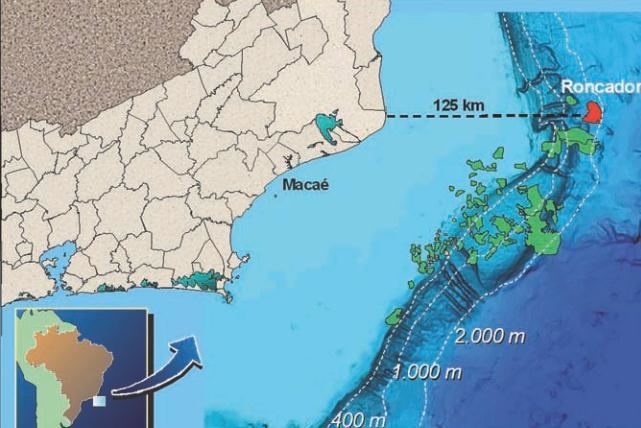Country Brazil Offshore/onshore Offshore Discovery 1996 Start of production 1999 | Block P-36 Peak year 2014 Operator Petrobras | |
 | ||
Current production of oil 460,000 barrels per day (~2.9×10^ t/a) Estimated oil in place 3,000 million barrels (~5.1×10^ t) | ||
Roncador oil field is a large oil and gas field located in the Campos Basin, 125 km (78 mi) off the coast of Brazil, northeast from Rio de Janeiro. It covers a 111 km2 (43 sq mi) area and reaches depths between 1,500 and 1,900 metres (4,900 and 6,200 ft).
Contents
History
The field was discovered in October 1996 and is located in P-36 block. The operator Petrobras had been preparing for a deepwater technical challenge such as Roncador under its PROCAP (Petrobras Technological Development Program on Deep Water Production Systems) and PROCAP-2000 initiatives. The field is considered to be a major breakthrough. It involves world’s first drill pipe riser, subsea tree and early production riser (EPR) rated for 2,000 metres (6,600 ft). Roncador has 53 production wells, 29 injection wells and is anticipated to peak in 2014.
Oil platform accident
Until 2001, the field was developed using Petrobras 36 oil production platform. In the early hours of March 15, 2001 there were two unexplained explosions in the aft starboard column. At the time there were 175 people on the platform; 11 were killed. Following the explosions, the platform developed a 16° list, sufficient to allow down-flooding from the submerged fairlead boxes. Marine salvage teams tried over the weekend to save the platform by pumping nitrogen and compressed air into the tanks to expel the water, but they abandoned the rig after bad weather. The platform sank five days after the explosions (March 20), in 1,200 m (3,940 ft) of water with an estimated 1,500 tonnes (1,700 short tons) of crude oil remaining on board.
Ownership
The field is fully owned and operated by Petrobras. It is estimated that Petrobras will spend nearly $2.2 billion on a project finance basis.
Reservoir
Roncador has 3 billion barrels of proven recoverable oil reserves. Due to its size the field was divided into four sections: Module 1 (28-31° API), Module 2 (18° API), Module 3 (22° API) and Module 4 (18° API) with subsequent division of the project into several phases.
Production
Field development on Roncador was divided into several phases:
